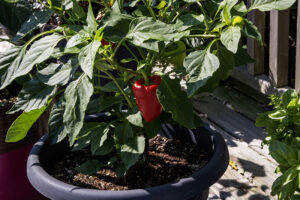Consider Edible Landscaping
By Deborah Jeanne Sergeant
 You don’t have to own a farm to grow food. If you have a bit of land or even a porch or patio, you can grow a few things that are edible — and that look good with your current landscaping.
You don’t have to own a farm to grow food. If you have a bit of land or even a porch or patio, you can grow a few things that are edible — and that look good with your current landscaping.
“It’s doable,” said Sarah Van Eenwyk, general manager at Grandpa’s Nursery & Gardens in Sodus. “I have a friend who plants a tomato plant in her landscaping bed every year with a tomato cage. Even the ones you buy at a garden store that are galvanized, you can paint a pretty color.”
Just as with any other planting, growing plants for food requires learning about how large the plants will become and what other needs they may have such as a trellis or fence for training vines or canes. It also helps to use attractive mulch around them to suppress weeds, help retain moisture and make it easier to mow around them.
Shrubs that bear fruit are an easy choice for Van Eenwyk.
“People are putting blueberries in their gardens and landscaping,” she said.
Deer like to eat the bushes, so planting blueberries closer to the house may help ward them off. But allow space on all sides of the bushes so you can harvest all the fruit. That’s tough if the bushes are flat against the house.
Consider fruit trees instead of ornamentals. However, note if the trees are self-pollinating or require male and female trees to bear fruit. Follow the nursery’s directions for fertilizing, pruning and spraying for pests. It also helps to promptly pick up any dropped fruit so it does not attract pests and disease.
 “Customers are doing a lot more container gardening, too, like sage,” Van Eenwyk said. “It’s a perennial crop you can grow in your perennial flower garden. It’s easy to grow. Rosemary is a little touchy. Many grow it in a container and bring it inside as it won’t survive the winter. Basil and parsley do very well in container gardening.”
“Customers are doing a lot more container gardening, too, like sage,” Van Eenwyk said. “It’s a perennial crop you can grow in your perennial flower garden. It’s easy to grow. Rosemary is a little touchy. Many grow it in a container and bring it inside as it won’t survive the winter. Basil and parsley do very well in container gardening.”
Many herbs can become invasive so it’s wise to harvest them often. You can always dry it if you can’t use it fast enough as fresh. Or give it away.
Strawberries can grow in containers or hanging baskets. Van Eenwyk said that strawberries can even make pretty groundcover.
Plants such as tomatoes and cucumbers look good in landscaping, especially if you use fertilizer that includes calcium. Use horticultural oil to help prevent blight and powdery mildew, since these plants are very prone to these diseases.

Since the pandemic, Kyle Van Putte, president and CEO of Van Putte Gardens in Rochester, has noticed an uptick in people interested in hobby gardening — not growing and preserving a lot of produce, but raising a bit for fresh eating.
“Even the most novice gardeners buy cherry tomato plants in a three-gallon pot,” he said. “It will bear fruit a month later. Another popular one is the jalapeno plant. It’s the ‘guacamole combo’ with a tomato plant, bell pepper and jalapeno. They aren’t necessarily putting in gardens in the ground, but container gardening. They want plants that will bear fruit in a few weeks, not two months.
“We’re also seeing a huge desire for blueberry bushes in pots. A lot want dwarf apple trees or pear trees. We are seeing a big push for people wanting to grow some food.”
Raised beds near pools and porches have become a trendy way to make growing edibles easier.
Before cultivating food plants, have the soil checked for lead, especially if near buildings. Root crops such as carrots, potatoes and turnips are especially prone to lead contamination if the soil has unhealthy lead levels. Don’t use salvaged wood for creating raised beds, fences or trellises around food plants. These may be contaminated with lead.
To find a lab to test soil for lead, visit https://apps.health.ny.gov/pubdoh/applinks/wc/elappublicweb/. You can also excavate and bring in purchased garden soil that’s safe for growing food to use in the areas where you plan to grow fruit and vegetable plants.

